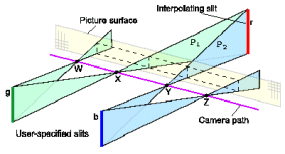Interactive Design of Multi-Perspective Images for Visualizing Urban Landscapes
Stanford University
Stanford University
Stanford University
IEEE Visualization 2004
Paper
Adobe Acrobat PDF (9.4 MB)

Figure: We visualize urban landscapes using serial blend of cross-slits cameras. The figure explains how we achieve this blending using two user specified cross-slits cameras, represented by slit pairs WX-g and YZ-b. Our system then automatically find the new slit r for interpolation, forming a new cross-slits camera represented by XY-r pair.
Video
MPEG-4 Video (20 MB)
Abstract
Multi-perspective images are a useful way to visualize extended, roughly planar scenes such as landscapes or city blocks. However, constructing effective multi-perspective images is something of an art. In this paper, we describe an interactive system for creating multi-perspective images composed of serially blended cross-slits images. Beginning with a sideways-looking video of the scene as might be captured from a moving vehicle, we allow the user to interactively specify a set of cross-slits cameras, possibly with gaps between them. In each camera, one of the slits is defined to be the camera path, which is typically horizontal, and the user is left to choose the second slit, which is typically vertical. The system then generates intermediate views between these cameras using a novel interpolation scheme, thereby producing a multi-perspective image with no seams. The user can also choose the picture surface in space onto which viewing rays are projected, thereby establishing a parameterization for the image. We show how the choice of this surface can be used to create interesting visual effects. We demonstrate our system by constructing multi-perspective images that summarize city blocks, including corners, blocks with deep plazas and other challenging urban situations.


Figure: These are the two multi-perspective images created using our sytem. The image on top is a traditional pushbroom panorama. Notice the standard pushbroom distortions, trees look thinner than they normally look and the view down the alley has been expanded making it almost unrecognizable. The image on bottom is the non-standard multi-perspective image that we create. Note that the alleyway now has the correct perspective. Also the trees look the right size. The bottom image was created using our interactive tool such that trees and the alley have the right perspective.